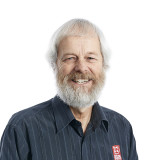Materials harnessing heat for unique energy needs
Our materials team hosted a transformative two-day workshop on thermoelectric technologies at the National Isotope Centre.
Drawing over 30 experts from Japan, Australia, New Zealand, and Spain we are proud to have forged new opportunities in international collaboration.
What are thermoelectric materials?
At their core, thermoelectric materials have a unique capability: they can convert temperature gradients directly into electrical power via the Seebeck effect. When heat moves across a thermoelectric material, it generates a small electrical voltage—a process that can be reversed to create a cooling effect (known as the Peltier effect).
This remarkable property means thermoelectric materials have a range of potential applications by utilising heat energy from natural sources like geothermal heat, and industrial sources such as "waste" heat produced from manufacturing processes.
Heat energy at temperatures under 300°C (called "low-enthalpy heat) is abundant, yet challenging, to convert to electricity with conventional methods.
This is where the opportunity lies for thermoelectric materials. Through a range of applications, these materials can enable more efficient energy use, reduce energy waste and generate electricity in otherwise conventionally inefficient circumstances using the energy of low-enthalpy heat.

What is the potential?
Aotearoa New Zealand is rich in geothermal heat at these low-enthalpy temperatures, with a broad temperature range available not just in our volcanic regions, but across the whole motu.
New Zealand also has unique needs for producing reliable and easily deployable electricity in incredibly remote locations, for example monitoring offshore volcanoes, powering isolated Antarctic research sites, and creating off-grid generation to support communities responding to natural disasters.
By capturing the temperature gradient between geothermal sources or environmental heat and the ambient air, thermoelectric devices could potentially generate zero-emissions power for off-grid sensors and monitoring equipment, enhancing resilience in monitoring New Zealand’s natural landscapes and supporting the tourism, conservation, and research sectors.

Why have the workshop?
Across the two day workshop, experts shared their research into emerging thermoelectric technologies and techniques that could provide solutions to a range of unique energy needs. The first day began with GNS Scientist Brian Carey showcasing the specific opportunity New Zealand has to utilise thermoelectric technology to harness the power of our low-enthalpy geothermal heat. Then, Professor David Astrain from the Public University of Navarre in Spain shared examples of how thermoelectric technology has successfully utilised geothermal heat to generate essential electricity for locations like Antarctic research sites and National Park infrastructure.
The workshop discussed a wide array of innovative application ideas such as thermoelectric materials for wearable devices powered by body heat, which offer a sustainable alternative to batteries for low-power devices. These could be valuable for health monitoring, emergency response, and outdoor activities where access to traditional power sources is limited. Additionally, many industries, including manufacturing and transportation, generate waste heat during routine operations. Thermoelectric systems can help reclaim this energy, using it to power devices, enhance heating systems, or feed electricity back into the grid, thus reducing overall energy consumption.

Fostering global collaboration
GNS Principal Scientist John Kennedy said "We are proud that this workshop has laid the groundwork for future collaboration among scientists, engineers, and innovators, building a community around thermoelectric research and applications in New Zealand and beyond. This has been a rare opportunity for cross-pollination of ideas from experts across the globe, and has opened doors to potential international partnerships that could accelerate the development of practical, scalable thermoelectric solutions."